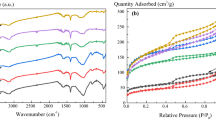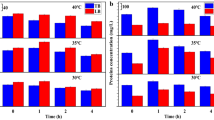Abstract
Electroplating sludge contained multi-metals and organics. In previous reports, electroplating sludges were usually recycled by direct calcination and pyrolysis for structural regulations. For the first time, a metal–organic framework synthesis method was utilized to regulate the structure of an electroplating sludge. In brief, the sludge was hydrothermally treated in solution of 1,3,5-trimesic acid, ethanol, and N,N-dimethylformamide. After this strategy, the sludge particle size was decreased; metals and organics formed coordination bond, and transformed oxygen-centered radicals to carbon-centered radicals; amorphous phases were re-crystalized to form well-dispersed crystals. As a result, the regulated sludge showed an enhanced denitrification activity. It removed 61.6% of nitric oxide (990 ppm) at a temperature as low as 150 °C. The activity was even close to 99.9% at 350 °C. What is more, the regulated sludge was characterized by plenty of free carboxylic groups and multi-metal catalytic centers, which make it a better catalyst than the pure-reagent-synthesized catalyst. Therefore, this paper put forward a novel strategy for the high value-added utilization of electroplating sludge.





Similar content being viewed by others
References
Mao L, Wu Y, Hu L, Huang Q, Dai Z, Zhang W (2019) Activity calculation and phase transformation predication for heavy metals with slag activity calculation model during using electroplating sludge in production of bricks. J Environ Chem Eng 7:103242
Peng G, Deng S, Liu F, Qi C, Tao L, Li T, Yu G (2020) Calcined electroplating sludge as a novel bifunctional material for removing Ni(II)-citrate in electroplating wastewater. J Clean Prod 262:121416
Asavapisit S, Chotklang D (2004) Solidification of electroplating sludge using alkali-activated pulverized fuel ash as cementitious binder. Cem Concr Res 34:349–353
Fernández Pereira C, Luna Y, Querol X, Antenucci D, Vale J (2009) Waste stabilization/solidification of an electric arc furnace dust using fly ash-based geopolymers. Fuel 88:1185–1193
Chen H, Yuan H, Mao L, Hashmi MZ, Xu F, Tang X (2020) Stabilization/solidification of chromium-bearing electroplating sludge with alkali-activated slag binders. Chemosphere 240:124885
Wu C, Zhang H, He P, Shao L (2010) Thermal stabilization of chromium slag by sewage sludge: effects of sludge quantity and temperature. J Environ Sci 22:1110–1115
Zhang B, Wang Y, Tang X, Wang S, Wei C, Wang R, Zhang W (2019) Oxidation of high iron content electroplating sludge in supercritical water: stabilization of zinc and chromium. Environ Sci Pollut Res 26:15001–15010
Mao L, Tang R, Wang Y, Guo Y, Su P, Zhang W (2018) Stabilization of electroplating sludge with iron sludge by thermal treatment via incorporating heavy metals into spinel phase. J Clean Prod 187:616–624
Gomez E, Rani DA, Cheeseman CR, Deegan D, Wise M, Boccaccini AR (2009) Thermal plasma technology for the treatment of wastes: a critical review. J Hazard Mater 161:614–626
Wu P, Zhang LJ, Lin CB, Xie XX, Yong XY, Wu XY, Zhou J, Jia HH, Wei P (2020) Extracting heavy metals from electroplating sludge by acid and bioelectrical leaching using Acidithiobacillus ferrooxidans. Hydrometallurgy 191:105225
Zhu X-H, Xie F, Li J, Jin G-P (2015) Simultaneously recover Ni, P and S from spent electroless nickel plating bath through forming graphene/NiAl layered double-hydroxide composite. J Environ Chem Eng 3:1055–1060
García V, Margallo M, Aldaco R, Urtiaga A, Irabien A (2013) Environmental sustainability assessment of an innovative Cr (III) passivation process. ACS Sustain Chem Eng 1:481–487
Li H, Yang X, Xu W, Wu J, Xu J, Zhang G, Xia Y (2014) Application of dry composite electroplating sludge into preparation of cement-based decorative mortar as green pigment. J Clean Prod 66:101–106
Tang Y, Chan SW, Shih K (2014) Copper stabilization in beneficial use of waterworks sludge and copper-laden electroplating sludge for ceramic materials. Waste Manag 34:1085–1091
Zhang J, Zhang J, Xu Y, Su H, Li X, Zhou JZ, Qian G, Li L, Xu ZP (2014) Efficient selective catalytic reduction of NO by novel carbon-doped metal catalysts made from electroplating sludge. Environ Sci Technol 48:11497–11503
Cao Z, Zhang J, Zhou J, Ruan X, Chen D, Liu J, Liu Q, Qian G (2017) Electroplating sludge derived zinc-ferrite catalyst for the efficient photo-Fenton degradation of dye. J Environ Manag 193:146–153
Sushil S, Scholz P, Pollok K, Ondruschka B, Batra VS (2011) Application of industrial waste based catalysts for total oxidation of propane. Chem Eng J 166:568–578
Chen M, Zhou J, Zhang J, Zhang J, Chen Z, Ding J, Kong F, Qian G, Chen J (2017) Ferrite catalysts derived from electroplating sludge for high-calorie synthetic natural gas production. Appl Catal A 534:94–100
Zhang C, Song J, Zhang J, Zhang J, Xing J, Hu D, Peng Y, Zhou J, Liu Q, Gu H, Qian G (2018) Understanding and application of an electroplating sludge-derived catalyst with an active texture for improved NO reduction. Sci Total Environ 631–632:308–316
Huang YB, Liang J, Wang XS, Cao R (2017) Multifunctional metal-organic framework catalysts: synergistic catalysis and tandem reactions. Chem Soc Rev 46:126–157
Qin Y-H, Huang L, Zhang D-L, Sun L-G (2016) Mixed-node A-Cu-BTC and porous carbon based oxides derived from A-Cu-BTC as low temperature NO–CO catalyst. Inorg Chem Commun 66:64–68
Jiang H, Zhou J, Wang C, Li Y, Chen Y, Zhang M (2017) Effect of cosolvent and temperature on the structures and properties of Cu-MOF-74 in low-temperature NH3-SCR. Ind Eng Chem Res 56:3542–3550
Jiang H, Wang Q, Wang H, Chen Y, Zhang M (2016) MOF-74 as an efficient catalyst for the low-temperature selective catalytic reduction of NOx with NH3. ACS Appl Mater Interfaces 8:26817–26826
Peng B, Feng C, Liu S, Zhang R (2018) Synthesis of CuO catalyst derived from HKUST-1 temple for the low-temperature NH3-SCR process. Catal Today 314:122–128
Zhao L, Zhang Y, Bi S, Liu Q (2019) Metal–organic framework-derived CeO2–ZnO catalysts for C3H6-SCR of NO: an in situ DRIFTS study. RSC Adv 9(33):19236–19242
Zhao Q, Zhu L, Lin G, Chen G, Liu B, Zhang L, Duan T, Lei J (2019) Controllable synthesis of porous Cu-BTC@polymer composite beads for iodine capture. ACS Appl Mater Interfaces 11:42635–42645
Kaur R, Kaur A, Umar A, Anderson WA, Kansal SK (2019) Metal organic framework (MOF) porous octahedral nanocrystals of Cu-BTC: synthesis, properties and enhanced adsorption properties. Mater Res Bull 109:124–133
Li Y, Wan Y, Li Y, Zhan S, Guan Q, Tian Y (2016) Low-temperature selective catalytic reduction of NO with NH3 over Mn2O3-doped Fe2O3 hexagonal microsheets. ACS Appl Mater Interfaces 8:5224–5233
Dong L, Gao S, Song W, Xu G (2007) Experimental study of NO reduction over biomass char. Fuel Process Technol 88:707–715
Wang G, Zhang J, Liu L, Zhou J-Z, Liu Q, Qian G, Xu Z-P, Richards R-M (2018) Novel multi-metal containing MnCr catalyst made from manganese slag and chromium wastewater for effective selective catalytic reduction of nitric oxide at low temperature. J Clean Prod 183:917–924
Shi Y, Pu J, Gao L, Shan S (2021) Selective catalytic reduction of NOx with NH3 and CH4 over zeolite supported indium-cerium bimetallic catalysts for lean-burn natural gas engines. Chem Eng J 403:126394
Svintsitskiy DA, Kardash TY, Stonkus OA, Slavinskaya EM, Stadnichenko AI, Koscheev SV, Chupakhin AP, Boronin AI (2013) In situ XRD, XPS, TEM, and TPR study of highly active in CO oxidation CuO nanopowders. J Phys Chem C 117:14588–14599
Jiang L-Y, Xin S, Wu X-L, Li H, Guo Y-G, Wan L-J (2010) Non-sacrificial template synthesis of Cr2O3–C hierarchical core/shell nanospheres and their application as anode materials in lithium-ion batteries. J Mater Chem 20:7565–7569
Xu K, Zou R, Li W, Xue Y, Song G, Liu Q, Liu X, Hu J (2013) Self-assembling hybrid NiO/Co3O4 ultrathin and mesoporous nanosheets into flower-like architectures for pseudocapacitance. J Mater Chem A 1:9107–9113
Lee S, Yoon J-S, Kang S, Kwon K, Chang KS, Lee S, Choi S-I, Jeong J-R, Lee G, Nam KM (2016) Sustainable method for the large-scale preparation of Fe3O4 nanocrystals. J Am Ceram Soc 99:2578–2584
Seo Y-K, Hundal G, Jang IT, Hwang YK, Jun C-H, Chang J-S (2009) Microwave synthesis of hybrid inorganic–organic materials including porous Cu3(BTC)2 from Cu(II)-trimesate mixture. Microporous Mesoporous Mater 119:331–337
Wang LJ, Zhou Q, Liang Y, Shi H, Zhang G, Wang B, Zhang W, Lei B, Wang WZ (2013) Size effect and enhanced photocatalytic activity of CuO sheet-like nanostructures prepared by a room temperature solution phase chemical method. Appl Surf Sci 271:136–140
Sharma RK, Ghose R (2015) Synthesis of porous nanocrystalline NiO with hexagonal sheet-like morphology by homogeneous precipitation method. Superlattices Microstruct 80:169–180
Sun T-W, Zhu Y-J, Qi C, Ding G-J, Chen F, Wu J (2016) α-Fe2O3 nanosheet-assembled hierarchical hollow mesoporous microspheres: microwave-assisted solvothermal synthesis and application in photocatalysis. J Colloid Interface Sci 463:107–117
Anandan K, Rajendran V (2015) Sheet, spherical and plate-like chromium sesquioxide (Cr2O3) nanostructures synthesized via ionic surfactants assisted facile precipitation method. Mater Lett 146:99–102
Rahman SK, Maimunawaro RA, Syauqiah I, Elma M (2020) Functionalization of hybrid organosilica based membranes for water desalination – preparation using Ethyl Silicate 40 and P123. Mater Today Proc 31:60–64
Gao X, Leng C, Zeng G, Fu D, Zhang Y, Liu Y (2019) Ozone initiated heterogeneous oxidation of unsaturated carboxylic acids by ATR-FTIR spectroscopy. Spectrochim Acta Part A 214:177–183
Ahmed OH, Altarawneh M, Al-Harahsheh M, Jiang Z-T, Dlugogorski BZ (2020) Formation of phenoxy-type environmental persistent free radicals (EPFRs) from dissociative adsorption of phenol on Cu/Fe and their partial oxides. Chemosphere 240:124921
Liao S, Pan B, Li H, Zhang D, Xing B (2014) Detecting free radicals in biochars and determining their ability to inhibit the germination and growth of corn, wheat and rice seedlings. Environ Sci Technol 48:8581–8587
Lomnicki S, Truong H, Vejerano E, Dellinger B (2008) Copper oxide-based model of persistent free radical formation on combustion-derived particulate matter. Environ Sci Technol 42:4982–4988
Shi W, Zhang J, Li X, Zhou J, Pan Y, Liu Q, Xu ZP, Qian G (2017) Synergistic effect between surface anhydride group and carbon–metal species during catalytic reduction of nitric oxide. Energy Fuels 31:11258–11265
Acknowledgements
This project was financially supported by the National key research and development program of China (2019YFC1906900). We appreciate the help of the Instrumental Analysis and Research Center of Shanghai University in sample characterization.
Author information
Authors and Affiliations
Corresponding authors
Ethics declarations
Conflict of interest
The authors declare no competing financial interest.
Additional information
Publisher's Note
Springer Nature remains neutral with regard to jurisdictional claims in published maps and institutional affiliations.
Supplementary Information
Below is the link to the electronic supplementary material.
Rights and permissions
About this article
Cite this article
Ma, J., Li, C., Hu, L. et al. Structural regulation of electroplating sludge by a metal–organic framework synthesis method for an enhanced denitrification activity. J Mater Cycles Waste Manag 23, 614–621 (2021). https://doi.org/10.1007/s10163-020-01146-8
Received:
Accepted:
Published:
Issue Date:
DOI: https://doi.org/10.1007/s10163-020-01146-8




